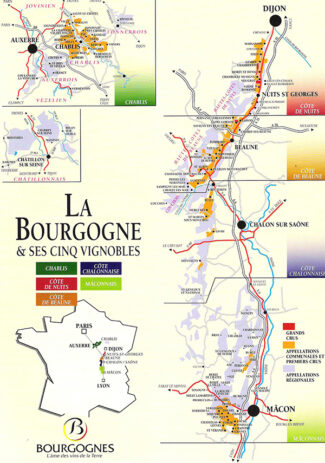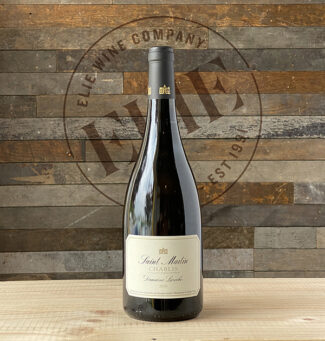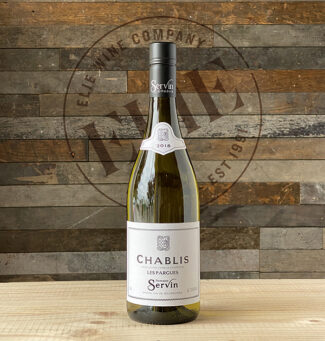Pure Burgundy: Chardonnay Never Had It So Good. The Flagship Cuvées of Four of Chablis’ Top-Tier Producers (8-Bottle Pack $298, All Included)
When Chardonnay is grown in climates less than ideal, resulting flaws are often tempered by oak. If such wines are described as cedary, buttery, vanilla-like or toasty, and chances are, the taster is defining qualities derived from the barrels used to ferment or mature the wine, because these are not qualities of the grape itself. Mineral notes like chalk, slate, schist or even powdered silica are the domain of the fruit; they are Chardonnay flavors, most of derived from the soil in which the grape vine grows.
Chablis—Burgundy’s most northerly appellation—produces the world’s most bracing and refreshingly uncluttered incarnation of Chardonnay. In Chablis, traditions are born of an ego that is mostly justified, and winemakers insist that the expression of the fruit be pure. That is not to say that no Chablis sees oak; many certainly do. It’s just that the whole approach to what barreling is supposed to accomplish in a glass is viewed differently in this rocky, chilly, outpost, less than a hundred miles from that other bastion of varietal purity, Sancerre.
 Chablis is subdivided into four AOPs based on quality factors which nearly all come down to soil and slope and grape yields. The largest of these, simply called Chablis, covers about sixteen thousand acres; the smallest, designated Grand Cru, is only a couple hundred acres in size and is limited to seven vineyards. To Chardonnay fans, these are like the seven celestial Pleiades in Greek mythology; their name on a Chablis bottle is tantamount to magic and an expectation thereof. The Premier Cru designation can be affixed to any of seventeen vineyards on both sides of the River Serein; the best occupy the right bank near the Grand Crus; the rest are southwest of the city of Chablis.
Chablis is subdivided into four AOPs based on quality factors which nearly all come down to soil and slope and grape yields. The largest of these, simply called Chablis, covers about sixteen thousand acres; the smallest, designated Grand Cru, is only a couple hundred acres in size and is limited to seven vineyards. To Chardonnay fans, these are like the seven celestial Pleiades in Greek mythology; their name on a Chablis bottle is tantamount to magic and an expectation thereof. The Premier Cru designation can be affixed to any of seventeen vineyards on both sides of the River Serein; the best occupy the right bank near the Grand Crus; the rest are southwest of the city of Chablis.
It remains testimony to Chablis’ ‘amour-propre’ that the district is willing to count on breeding, not masking, to show off its wares.
This package includes two bottles from each of Chablis top-tier producers. (8-Bottle Pack $298, All Included)
Domaine Billaud-Simon
 Credit Napoléon’s loss at Waterloo for the establishment of Domaine Billaud-Simon; Charles Louis Noël Billaud returned home from the war to plant vines on the family holdings in Chablis. A century later, the estate expanded with the marriage of his descendent Jean Billaud to Renée Simon. Since 2014 owned by Erwan Faiveley, the 42-acre site produces wine from four Grand Cru vineyards, including single-acre plots in Les Clos and Les Preuses. The Domaine also owns four Premier Cru vineyards, including Montée de Tonnèrre, Mont-de-Milieu, Fourchaume and Vaillons. Chablis 2017 ‘Tête d’Or’ ($46) is sourced from 28-year-old vines from a parcel sitting at the foot of the Premier Cru Montée de Tonnerre in the heart of the Chablis appellation; the name means ‘Head of Gold’ and shows pure green-apple and bitter almond with an almost saline-like intensity. It’s a letter-perfect oyster wine, nicely nuanced with graphite, grapefruit and lemon.
Credit Napoléon’s loss at Waterloo for the establishment of Domaine Billaud-Simon; Charles Louis Noël Billaud returned home from the war to plant vines on the family holdings in Chablis. A century later, the estate expanded with the marriage of his descendent Jean Billaud to Renée Simon. Since 2014 owned by Erwan Faiveley, the 42-acre site produces wine from four Grand Cru vineyards, including single-acre plots in Les Clos and Les Preuses. The Domaine also owns four Premier Cru vineyards, including Montée de Tonnèrre, Mont-de-Milieu, Fourchaume and Vaillons. Chablis 2017 ‘Tête d’Or’ ($46) is sourced from 28-year-old vines from a parcel sitting at the foot of the Premier Cru Montée de Tonnerre in the heart of the Chablis appellation; the name means ‘Head of Gold’ and shows pure green-apple and bitter almond with an almost saline-like intensity. It’s a letter-perfect oyster wine, nicely nuanced with graphite, grapefruit and lemon.
Domaine Billaud-Simon
Domaine Laroche
 Vines were first planted in the confines of what is today Laroche the same year that algebra was invented; in 2021, both mathematics and Laroche are still going strong. Today, Domaine Laroche is one of the largest landholders of Grand Cru vineyards in Chablis, with 222 acres spread across the entire region. Michel Laroche—whose name is held in the same reverence in Chablis as Michel Chapoutier’s is in northern Rhône or Olivier Humbrecht’s in Alsace—relies on one-man plots, meaning that a single person is wholly responsible for the care of each vineyard parcel, from the pruning, soil conditioning and control of yields to the sorting of the harvest. Chablis 2018 ‘Saint-Martin’ ($32) is named for the patron saint of Chablis, a Roman cavalry officer who became a monk and was elected Bishop of Tours. The cuvée is a blend of the best plots, all sit on Chablis’ legendary Kimmeridgian soil, and produce excellent acidity and remarkable finesse. The wine shows Bartlett pear and lily on the nose, pineapple and honey in the mid-palate and violet and candied lemon on the textured, creamy finish.
Vines were first planted in the confines of what is today Laroche the same year that algebra was invented; in 2021, both mathematics and Laroche are still going strong. Today, Domaine Laroche is one of the largest landholders of Grand Cru vineyards in Chablis, with 222 acres spread across the entire region. Michel Laroche—whose name is held in the same reverence in Chablis as Michel Chapoutier’s is in northern Rhône or Olivier Humbrecht’s in Alsace—relies on one-man plots, meaning that a single person is wholly responsible for the care of each vineyard parcel, from the pruning, soil conditioning and control of yields to the sorting of the harvest. Chablis 2018 ‘Saint-Martin’ ($32) is named for the patron saint of Chablis, a Roman cavalry officer who became a monk and was elected Bishop of Tours. The cuvée is a blend of the best plots, all sit on Chablis’ legendary Kimmeridgian soil, and produce excellent acidity and remarkable finesse. The wine shows Bartlett pear and lily on the nose, pineapple and honey in the mid-palate and violet and candied lemon on the textured, creamy finish.
Domaine Laroche
Christian Moreau Père & Fils
 The pedigree of the Moreau name dates to 1814 when barrel-maker Jean-Joseph Moreau founded a wine-merchant trading firm in Chablis. Although that original firm has changed hands several times, including a sale to Hiram Walker in 1985 and again to the Boissets of Nuits-Saint-Georges in 1998, the Moreau family never relinquished control of their vineyards. Domaine Christian Moreau Père et Fils began vinifying at the turn of the 21st century, and is now under the watchful care of Fabien Moreau: “Being the 6th generation of the family producing wines, was and still is a challenge for me, trying to avoid the pressure you could have with this wine heritage. But with the quality of the vineyard that my family passed on, the basis of the expression of our wines is here, and our work is to honor our terroirs.” Chablis 2018 ($36) is a cuvée built from grapes purchased from the bordering villages of Fontenay-Près-Chablis (near Fourchaume) and Béru. It is a taut, compelling wine that reflects a mineral-tinged sharpness that the French describe as ‘goût de pierre à fusil’—gunflint—alongside aromas white hawthorn flowers and a cut of citrus.
The pedigree of the Moreau name dates to 1814 when barrel-maker Jean-Joseph Moreau founded a wine-merchant trading firm in Chablis. Although that original firm has changed hands several times, including a sale to Hiram Walker in 1985 and again to the Boissets of Nuits-Saint-Georges in 1998, the Moreau family never relinquished control of their vineyards. Domaine Christian Moreau Père et Fils began vinifying at the turn of the 21st century, and is now under the watchful care of Fabien Moreau: “Being the 6th generation of the family producing wines, was and still is a challenge for me, trying to avoid the pressure you could have with this wine heritage. But with the quality of the vineyard that my family passed on, the basis of the expression of our wines is here, and our work is to honor our terroirs.” Chablis 2018 ($36) is a cuvée built from grapes purchased from the bordering villages of Fontenay-Près-Chablis (near Fourchaume) and Béru. It is a taut, compelling wine that reflects a mineral-tinged sharpness that the French describe as ‘goût de pierre à fusil’—gunflint—alongside aromas white hawthorn flowers and a cut of citrus.
Domaine Christian Moreau
Domaine Servin
 When you’ve been growing wine grapes in Chablis since 1547, post-Napoleonic upstart houses are the new kids on the block. With so many generations of winemakers and a pantheon of awards that span centuries, it is to be expected that the philosophy of Chablis, when uttered by a Servin, should be heeded. Says François Servin, the current winemaker, who was raised on vintages like 1929, 1947 and 1959: “A good Chablis is not a wine which is very elegant when young; Chablis for me is a wine which is good over 20 years.” This keen understanding of older vintages convinced him that malolactic fermentation combined with late bottling increases the ageing capacity of his wines. Chablis 2018 ‘Les Pargues’ ($27), planted in the vineyards behind the Premier Crus Vaillons and Montmains, employs a judicious blend of barrels and stainless-steel vats to create a wine that is concentrated and mineral-driven, showing natural mellowness, a touch of anise and lemon-peel balanced by smoke and earth.
When you’ve been growing wine grapes in Chablis since 1547, post-Napoleonic upstart houses are the new kids on the block. With so many generations of winemakers and a pantheon of awards that span centuries, it is to be expected that the philosophy of Chablis, when uttered by a Servin, should be heeded. Says François Servin, the current winemaker, who was raised on vintages like 1929, 1947 and 1959: “A good Chablis is not a wine which is very elegant when young; Chablis for me is a wine which is good over 20 years.” This keen understanding of older vintages convinced him that malolactic fermentation combined with late bottling increases the ageing capacity of his wines. Chablis 2018 ‘Les Pargues’ ($27), planted in the vineyards behind the Premier Crus Vaillons and Montmains, employs a judicious blend of barrels and stainless-steel vats to create a wine that is concentrated and mineral-driven, showing natural mellowness, a touch of anise and lemon-peel balanced by smoke and earth.
- - -
Posted on 2021.06.03 in France, Burgundy
Featured Wines
- Notebook: A’Boudt Town
- Saturday Sips Wines
- Saturday Sips Review Club
- The Champagne Society
- Wine-Aid Packages
Wine Regions
Grape Varieties
Aglianico, Albarino, Albarín Blanco, Albarín Tinto, Albillo, Aleatico, Arbanne, Aubun, Barbarossa, barbera, Beaune, Biancu Gentile, bourboulenc, Cabernet Franc, Cabernet Sauvignon, Caino, Caladoc, Calvi, Carcajolu-Neru, Carignan, Chablis, Chardonnay, Chasselas, Clairette, Corvina, Cot, Counoise, Erbamat, Ferrol, Fiano, Frappato, Friulano, Fromenteau, Fumin, Garnacha, Gewurztraminer, Godello, Graciano, Grenache, Grolleau, Groppello, Juan Garcia, Lambrusco, Loureira, Macabeo, Macabou, Malvasia, Malvasia Nera, Marsanne, Marselan, Marzemino, Melon de Bourgogne, Merlot, Mondeuse, Montanaccia, Montepulciano, Morescola, Morescono, Moscatell, Muscadelle, Muscat, Natural, Nero d'Avola, Parellada, Patrimonio, Petit Meslier, Petit Verdot, Pineau d'Aunis, Pinot Auxerrois, Pinot Blanc, Pinot Gris, Pinot Meunier, Pinot Noir, Poulsard, Prieto Picudo, Rondinella, Rousanne, Roussanne, Sangiovese, Sauvignon Blanc, Savignin, Semillon, Souson, Sparkling, Sumoll, Sylvaner, Syrah, Tannat, Tempranillo, Trebbiano, Trebbiano Valtenesi, Treixadura, Trousseau, Ugni Blanc, vaccarèse, Verdicchio, Vermentino, Viognier, Viura, Xarel-loWines & Events by Date
- April 2024
- March 2024
- February 2024
- January 2024
- December 2023
- November 2023
- October 2023
- September 2023
- August 2023
- July 2023
- June 2023
- May 2023
- April 2023
- March 2023
- February 2023
- January 2023
- December 2022
- November 2022
- October 2022
- September 2022
- August 2022
- July 2022
- June 2022
- May 2022
- April 2022
- March 2022
- February 2022
- January 2022
- December 2021
- November 2021
- October 2021
- September 2021
- August 2021
- July 2021
- June 2021
- May 2021
- April 2021
- March 2021
- February 2021
- January 2021
- December 2020
- November 2020
- October 2020
- September 2020
- August 2020
- July 2020
- June 2020
- May 2020
- April 2020
- March 2020
- February 2020
- January 2020
- December 2019
- November 2019
- October 2019
- September 2019
- August 2019
- July 2019
- June 2019
- May 2019
- April 2019
- March 2019
- February 2019
- January 2019
- December 2018
- November 2018
- October 2018
- September 2018
- August 2018
- July 2018
- June 2018
- May 2018
- April 2018
- March 2018
- February 2018
- January 2018
- December 2017
- November 2017
- October 2017
- September 2017
- August 2017
- July 2017
- June 2017
- May 2017
- April 2017
- March 2017
- February 2017
- January 2017
- December 2016
- November 2016
- October 2016
- September 2016
- August 2016
- July 2016
- June 2016
- May 2016
- April 2016
- March 2016
- February 2016
- January 2016
- December 2015
- November 2015
- October 2015
- September 2015
- August 2015
- July 2015
- June 2015
- May 2015
- April 2015
- March 2015
- February 2015
- January 2015
- December 2014
- November 2014
- October 2014
- September 2014
- August 2014
- July 2014
- June 2014
- April 2014
- March 2014
- February 2014
- January 2014
- December 2013
- November 2013
- October 2013
- September 2013
- August 2013
- July 2013
- June 2013
- May 2013
- April 2013
- March 2013
- February 2013
- January 2013
- December 2012
- November 2012
- October 2012
- February 2004
Search



